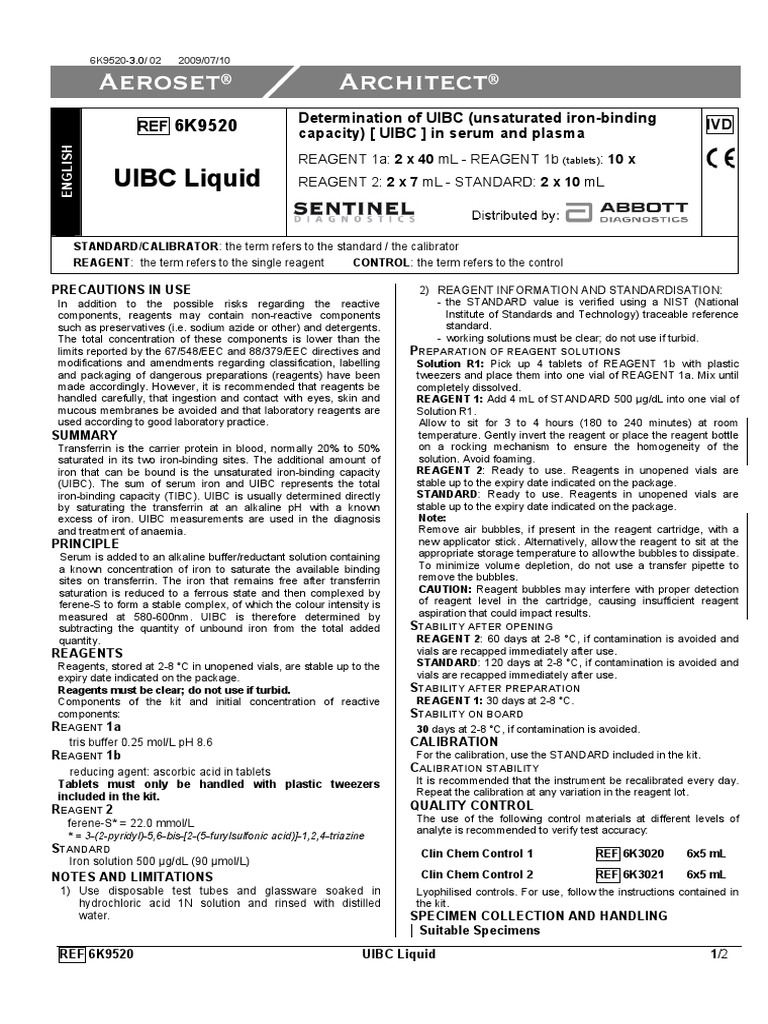In the intricate world of hematology, one term that often elicits curiosity yet remains underappreciated is Unsaturated Iron-Binding Capacity, or UIBC. Understanding UIBC is pivotal for comprehending an individual’s iron metabolism and overall health. This particular blood test can unveil much about the body’s iron stores, offering insights that transcend basic bloodwork. This exposition delves deeply into what UIBC is, its significance, the methods used to assess it, and the underlying biological mechanisms at play.
To begin with, iron plays a crucial role in various physiological processes, predominantly in the formation of hemoglobin—the protein responsible for oxygen transport in red blood cells. When assessing iron metabolism, healthcare practitioners frequently evaluate several metrics, including serum iron, ferritin, total iron-binding capacity (TIBC), and, of course, UIBC. The latter provides a unique perspective into the body’s capacity to bind iron when reserves are less than optimal.
UIBC specifically measures the amount of iron that can be bound by transferrin, the primary protein responsible for transporting iron in the bloodstream. Transferrin saturation, which is calculated using the values from serum iron and TIBC, reflects the percentage of transferrin that is filled with iron. Herein lies the significance of UIBC: it informs clinicians about the reserve capacity of the body’s iron-binding proteins, highlighting potential deficiencies or surpluses that may not be otherwise apparent.
The test itself is relatively straightforward. Blood is drawn, usually via a venipuncture, and the plasma is then analyzed to quantify both serum iron levels and the total iron-binding capacity. The UIBC is derived by subtracting the serum iron level from TIBC. This calculation provides a clear picture of how much iron can still be accommodated by transferrin, therefore assisting in diagnosing various conditions related to iron levels.
Why is it essential to measure UIBC? The implications are manifold. An elevated UIBC often suggests insufficient iron stores in the body, indicating a state of iron deficiency. This condition may arise from various factors such as dietary inadequacies, chronic blood loss, or malabsorption disorders. Conversely, a low UIBC can be indicative of conditions where there is an excess of iron, such as hemochromatosis or iron overload syndromes. Hence, UIBC serves as a barometer for iron metabolism, allowing healthcare providers to allocate necessary interventions effectively.
In the context of clinical practice, interpreting UIBC results necessitates a holistic approach. Alone, it does not provide a conclusive diagnosis; rather, it should be evaluated alongside other tests, including serum ferritin and TIBC. Together, these parameters create a comprehensive panorama of the patient’s iron status. For instance, if UIBC is high, serum ferritin is low, and TIBC is elevated, the suspicion for iron deficiency increases. Understanding these interrelationships empowers physicians to make informed decisions regarding treatment pathways.
Beyond clinical diagnostics, the implications of UIBC stretch into laboratory research and even nutritional science. Current studies are investigating the correlation between UIBC levels and various chronic diseases, aiming to establish a more profound understanding of how iron metabolism impacts overall health. For example, iron is a double-edged sword. While it is essential for many physiological processes, excessive iron can catalyze oxidative stress, contributing to cellular damage and chronic diseases.
In considering nutritional aspects, individuals often overlook the role of UIBC in dietary planning. For those concerned about their iron intake—whether due to dietary restrictions or health conditions—understanding UIBC can inform better decisions regarding iron supplementation. Individuals consuming a primarily vegetarian or vegan diet might find themselves facing a more significant risk of iron deficiency, making UIBC evaluations particularly essential in these populations. They might also consider combining iron-rich foods with vitamin C sources to enhance iron absorption, as the body’s iron-binding capacity plays a critical role in overall health.
Furthermore, the landscape around UIBC is continually evolving, spurred by advancements in medical research. Some recent studies have suggested novel markers in conjunction with UIBC that may provide deeper insights into iron metabolism and its broader health implications. This exploration underlines the necessity for ongoing research and a shift in how both healthcare providers and patients view iron status.
The discourse surrounding UIBC is increasingly gaining attention, emphasizing its utility beyond that of mere clinical diagnostics. It is becoming evident that monitoring UIBC could facilitate proactive management of iron-related health issues before they escalate into significant problems. It beckons a paradigm shift in understanding that iron deficiency is not just a matter of checking iron levels but involves a comprehensive assessment of the body’s ability to use and store iron effectively.
In essence, UIBC serves as a linchpin in deciphering the complexities of iron homeostasis. Awareness of this critical component opens avenues for enhanced diagnostic acumen and therapeutic interventions, resonating with the long-standing moniker that knowledge is power. By fostering a deeper appreciation for UIBC, both patients and healthcare providers can navigate the often convoluted waters of iron metabolism with more confidence and clarity. Ultimately, understanding UIBC is not just about iron; it represents a broader commitment to health and well-being that warrants attention and action.
